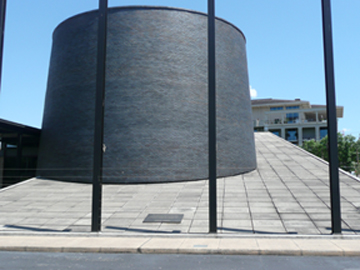|
Next to the strange structure is the main building, made out of reddish brick, with the main entrance at the point where the cylindrical structure and main building meet. Upon entering the building, I find myself facing a donation box. No fee is charged for admission, rather there is a suggested donation of $5 and a large box to put it in, or not. I again am struck by the design and aesthetics of the inside of the building. To my left is the main desk with security personnel as well as museum staff ready to answer questions. Just past them is a small bookshop with books, posters, and postcards dealing with everything from Judaism and peace to the rise of the Third Reich. Beneath me, the floors are a hard grey concrete. The walls are formed from lighter reddish bricks. Overhead and along the walls, dark iron girders attached with thick rivets act as functioning and nonfunctioning support structures. Air vents in the walls and ceiling are shaped in the more industrial looking, circular varieties than the square and rectangle ones we are accustomed to in most homes and buildings today.
|

|

|
The building is characterized by very high ceilings made up of grey concrete. At the back side, large windows, the panes of which are each surrounded in the same black iron, give off a feeling of confinement. In this main entrance area there are benches and chairs for people to sit and take in their surroundings. It seems as though the inside was designed to bring visitors into the aesthetic of the concentration camps. The dull grey colors, old-fashioned air vents, and large iron beams make the building feel industrial, efficient, and clean, all traits the Nazis strove for in their camps. Throughout this main entranceway and even outside, black pieces of granite with writing carved into them in white serve as information boards, providing information on who donated what, what represents what, and etc. This particular esthetic is repeated throughout the museum and seems to be a somewhat iconic, somewhat indexical symbol within the context of gravestones and commemoration. On the right side of the hall, just passed the entranceway, is a large black wall with metal lettering reading: "BEARING WITNESS: A community remembers". Just passed that, a pair of large glass doors serves as the entrance to the main, permanent exhibit.
|






